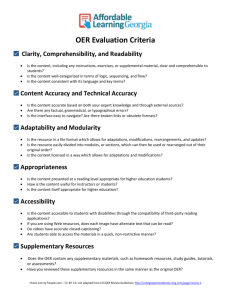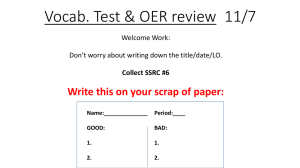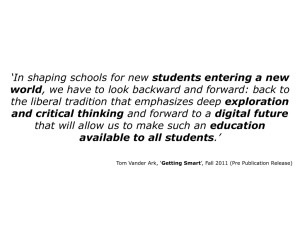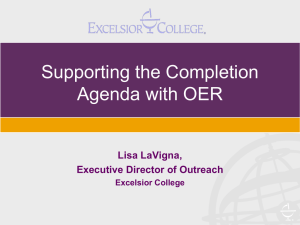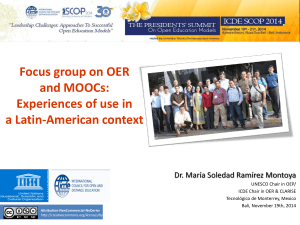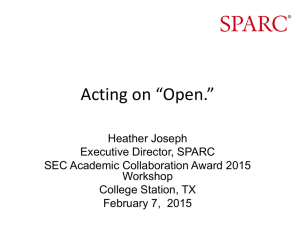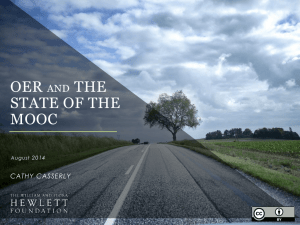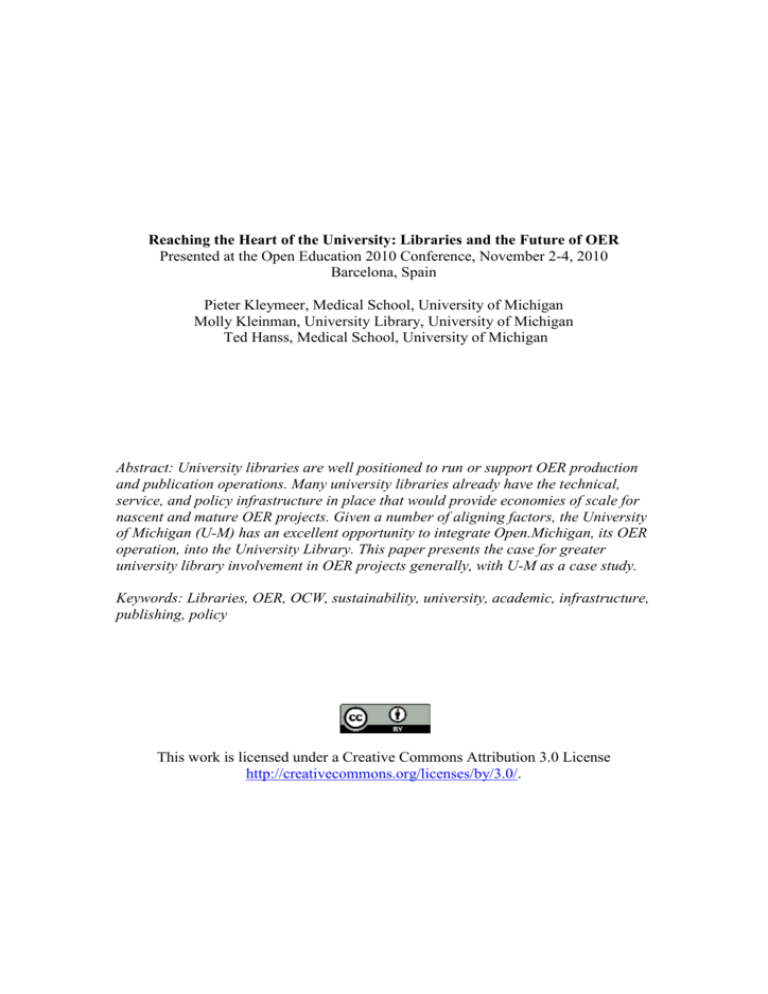
Reaching the Heart of the University: Libraries and the Future of OER
Presented at the Open Education 2010 Conference, November 2-4, 2010
Barcelona, Spain
Pieter Kleymeer, Medical School, University of Michigan
Molly Kleinman, University Library, University of Michigan
Ted Hanss, Medical School, University of Michigan
Abstract: University libraries are well positioned to run or support OER production
and publication operations. Many university libraries already have the technical,
service, and policy infrastructure in place that would provide economies of scale for
nascent and mature OER projects. Given a number of aligning factors, the University
of Michigan (U-M) has an excellent opportunity to integrate Open.Michigan, its OER
operation, into the University Library. This paper presents the case for greater
university library involvement in OER projects generally, with U-M as a case study.
Keywords: Libraries, OER, OCW, sustainability, university, academic, infrastructure,
publishing, policy
This work is licensed under a Creative Commons Attribution 3.0 License
http://creativecommons.org/licenses/by/3.0/.
Introduction
University libraries are well positioned to run or support open educational resource
(OER) production and publication operations, but so far most academic institutions
developing OER have little or no integration with their respective libraries. Many
university libraries already have the technical, service, and policy infrastructure in
place that would provide economies of scale for nascent and mature OER projects.
Given a number of aligning factors, the University of Michigan (U-M) has an
excellent opportunity to integrate Open.Michigan, its OER operation, into the
University Library. While the U-M Library’s established publishing apparatus is
larger than that of most academic libraries, many institutions share elements that
would make OER integration feasible in one form or another. This paper presents the
case for greater university library involvement in OER projects generally, with U-M
as a case study.
Libraries were among the first OER producers, digitizing and sharing digital content
even before the arrival of the public Internet. These early “digital library” projects
were spearheaded by libraries in support of their missions to collect, preserve, and
provide access to knowledge and information. In the United States, the Library of
Congress launched one of the first efforts with a pilot program in 1990 that became
the American Memory Historical Collections.i The program digitized public domain
historical materials from the Library’s collections, including documents, moving
images, sound recordings, and print and photographic media, and selected forty-four
schools and libraries across the country to receive CD-ROMs of all the materials. In
1994, after the internet had arisen as a viable multimedia distribution system, the
program moved online and the Library of Congress launched the National Digital
Library Program, “a pioneering systematic effort to digitize some of the foremost
historical treasures in the Library and other major research archives and make them
readily available on the Web to Congress, scholars, educators, students, the general
public, and the global Internet community.”ii With a wave of funding support from the
government (National Science Foundation Digital Library Initiative) and a handful of
committed foundations (The Andrew W. Mellon Foundation, the J. Paul Getty
Foundation and the W.K. Kellogg Foundation), similar projects soon sprung up at
university libraries across the country, notably including Harvard, Cornell, the
University of Virginia, and the University of Michigan (Greenstein and Thorin,
2002).
Many of the libraries that experimented with digital publishing in the 1990’s now
have established operations to share free content online, and they have been joined by
libraries large and small, academic and public, all with the same mission: to improve
access to scholarly, educational, and historical materials for everyone.iii Indeed, the
missions and goals of the new crop of OER initiatives align closely with those of
academic libraries. Academic OER initiatives and university libraries share a
determination to improve access to all kinds of scholarly and educational materials,
both on their campuses and throughout the world. Given those dovetailing values,
partnerships between OER initiatives and libraries seem not just logistically
convenient but philosophically obvious.
The Advantages of Libraries
In addition to this convenient philosophical convergence, there are two key
advantages that many university libraries share, and OER initiatives need:
infrastructure and relationships.
Infrastructure: Depending on the institution, areas where existing library
infrastructure could support OER include search and discovery, copyright expertise,
data storage, metadata and indexing, and institutional repositories and preservation.
Most OER shops are isolated in individual departments or as stand-alone units and do
not have access to the kind of robust support available in many libraries.iv In trying to
create duplicate infrastructure, OER groups may be missing opportunities to use
existing and proven systems.
- Search and discovery: For a long time, libraries have been engaged in the struggle to
help their users find the information they need quickly and seamlessly. Many
academic libraries have programmers and other experts working on the problem of
improving search results across large bodies of heterogeneous content in databases,
library catalogs, and across the open web. This expertise would be valuable to OER
operations that have invested a great deal in producing content, but have not yet
figured out how to make that content findable to all the people who could use it.v
- Copyright expertise: In recent years, many academic libraries have created positions
for copyright or scholarly communications specialists. These librarians provide
outreach and education to faculty, staff, and students on a range of issues including
publishing agreements, author rights, licensing contracts, and open access policies.
Access to this copyright expertise would serve OER initiatives in two ways: helping
to create policy and answer questions related to the use of third party content and
licensing in OER, and supporting outreach efforts by helping to educate faculty about
their rights as authors and creators and about the value of sharing.
- Data storage: In order to support the aforementioned digital collections, libraries
have access to excellent storage systems for electronic content, along with carefully
developed standards to keep those collections safe and accessible. Some run their own
servers, while others partner with the central campus IT provider or use an external
service, but the result is reliable storage that is protected against data loss and server
outages. The storage infrastructure available to OER initiatives varies widely across
institutions and depends a great deal on where the project is housed. On some
campuses, the storage options available outside the library may be better than those in
it, but on others the storage infrastructure in the library is top notch and would be an
excellent home for OER.
- Metadata and indexing: Libraries have been cataloguing and indexing materials for
centuries, and they have carried this expertise forward into the networked era.
Metadata experts in libraries could serve as consultants for OER projects, either
formally or informally, in order to help standardize and improve metadata for open
content.
- Institutional repositories and preservation: Universities across the country are
launching institutional repositories (IRs) to preserve and make available the scholarly
output from their campuses. Many OER projects either use dedicated OER or open
courseware publishing platforms such as eduCommons, learning management
systems like Sakai or Moodle, or have created their own, but these systems are not
designed for preservation of materials or formats. Using platforms like DSpace and
Fedora, IRs contain materials in a wide range of formats, and are committed both to
making the content freely available and discoverable on the open web, and to
preserving the content over the very long term. Few digital publishing operations have
concerned themselves with long-term preservation, and as a result gigabytes of born
digital content, websites and publications have already been lost (Brand, 1999).
Depositing OER into institutional repositories opens up a new potential avenue of
discovery while also ensuring that the material will be available for years to come.
Many of the infrastructural benefits in libraries could be available to OER initiatives
without formally becoming a part of the library. Indeed, for many OER shops,
collaborations with their libraries in some or all of these areas may be sufficient to
meet the needs of the project. However, the next advantage will be harder to
capitalize on through simple collaboration.
Relationships: Living at the heart of the University
Most university libraries have a central and trusted position in the lives of faculty,
students, and administrators on their campuses. Librarians support curriculum
development, guide instructors to appropriate learning content, and assist with
research. According to data collected by the Association for Research Libraries
(ARL), the average research library in the United States answers tens of thousands of
reference questions each year (ARL Statistics, 2009). While gate counts are not
collected by ARL, at a representative institution like the University of Washington,
which sits towards the middle of ARL size rankings, that number is in the millions.vi
Despite the changes brought by technology and the availability of scholarly and
educational content online, people on university campuses still use their libraries and
librarians every day. Areas in which librarians have skills that are relevant to OER
programs include outreach and education, curriculum development, and instructional
support.
- Outreach and education: Public services librarians spend their time developing
programming, reaching out to faculty and students, and teaching research skills. They
know intimately which outreach strategies will work best for different departments,
disciplines, and subcultures across campus. For OER projects that are struggling to
recruit more faculty participation, or to inform students of the existence and
usefulness of OER, librarians can offer not just guidance on effective marketing and
outreach, but also a direct and trusted line to faculty and students all over campus.
- Curriculum development: In many institutions, librarians are immersed in the
process of curriculum development and are engaged directly as facilitators in courses,
a position from which they can help both students and faculty access OER, and turn
course materials, both faculty and student produced, into OER.
- Instructional support: Some university libraries offer instructional design support,
and many more help faculty identify and locate materials to use in their courses.
Increasingly, librarians are using this role to point their faculty towards open content
of all kinds (Kleinman, 2008). When a course is taught with OER in mind from the
beginning, it is much easier to openly license it later.
When we refer to that oft-quoted line (so oft-quoted that we are not actually sure
whom to quote), “Libraries are the heart of universities,” what we mean is this:
Libraries are for everyone. Libraries provide services to every student, instructor, and
staff member from every school, college, and department on a campus. When libraries
are not beholden to the interests of a specific unit or department, they can be trusted to
direct their financial, personnel, and technical resources in a manner that will provide
the most benefit to the most people. This is exactly the kind of reputation OER
publishing initiatives should want to have. An affiliation with the library signifies
trustworthiness, sensibleness, and a commitment to the common good.
Case Study: OER and the Library at the University of Michigan
We now turn our attention to the case study underway at the University of Michigan.
In March 2010, a small group within the University Library submitted a report to
Dean of Libraries Paul Courant recommending that the Library launch a
University‐ wide program housed in its MPublishing unit to publish and collect OER.
The group argued that the Library should focus on integrating some or all of the
existing Open.Michigan OER operation into the Library to capitalize on the
experience and connections that operation had already built. Courant charged a task
force with researching the requirements for developing a University‐ wide OER
program in the Library, including the staffing and resource needs and potential
funding sources, and that task force delivered its report in August 2010. As of this
writing, the Library is in the process of making a final decision about taking on
responsibility for OER publishing at the University, but a number of collaborations
are already underway, and some of the groundwork has been completed.
Open.Michigan
Open.Michigan is a project based in the University of Michigan Medical School and
is dedicated to enabling educators, students and staff to make their instructional and
educational resources available to everyone in the world. It is supervised by Ted
Hanss, director of the Office of Enabling Technologies, which is a part of the dean’s
office in the Medical School. The Office of Enabling Technologies was created as an
incubator for new technologies, techniques, and activities that might be of use to the
instructional and research missions of the Medical School. The Open.Michigan
project was born from the initiative of a few graduate students and a dean’s
conviction that open education had a place in medical instruction.
The mission of Open.Michigan is to “enable faculty, students, staff and others to
share their educational resources and research with the global learning community.
Open.Michigan encourages researchers, learners, and instructors to maximize the
impact and reach of their scholarly work through open sharing.” Most of the activity
in service of this mission is directly related to OER production and publishing in
some form, but there is also an underlying effort to change the climate at the
University of Michigan to encourage sharing and foster a participatory learning
environment.
Open.Michigan consists of four major areas of activity:
1) The production of OER from U‐ M courses and learning materials, and outreach
and consulting services related to OER production: Open Education Specialists
partner with faculty who wish to create any form of OER, including courses,
textbooks, and datasets, support faculty who are seeking open content to use in their
teaching, and promote the use and creation of OER throughout the campus. This work
includes an effort to educate faculty about copyright and to encourage them to create
courses using material that is licensed for downstream copying and adaptation.
2) The development of processes and software to support OER production and
publishing: Open.Michigan developed a distributed OER production process called
dScribe, which uses student volunteers in U‐ M courses to collect course materials,
run them through a copyright clearance process, replace proprietary third party
materials with public domain or Creative Commons licensed content, and republish
the courses as OER in the Open.Michigan OER repository. To support this work,
Open.Michigan developed open source software called OERca that facilitates the
copyright clearance process. Open.Michigan also worked with a contractor to build an
open source OER publishing platform on Drupal.
3) The Open.Michigan website, which serves as a gateway to a wide spectrum of
“open” initiatives at the University of Michigan and collaborating institutions: This
website highlights relevant projects throughout the University, including many
Library initiatives, and serves as a publishing platform for over 60 courses and
resources produced as OER from 10 different units, schools and colleges at U‐ M.
4) African Health OER Network, a partnership between the U‐ M Medical School,
OER Africa, and several health science universities across the continent: Funded by
the Hewlett Foundation, the aim of the project is to improve health science education
in Africa and enable teaching resources to flow back and forth between U‐ M and
African health science schools. The participating schools are collaborating on content
creation, production and publishing development, and advocacy and policymaking
related to OER.
The University of Michigan Library
The University of Michigan Library in Ann Arbor is one of the largest university
library systems in the United States. Comprising several locations across campus, the
Library holds more than 8 million volumes and serves more than 3 million patrons per
year. In a typical year, the University Library teaches more than 1,000 classes to
20,000 undergraduates, graduate students, and faculty through course-integrated
instruction and technology-focused programs. The overarching mission of the
University Library is to support the research and scholarship of students and faculty.
In recent years, many non-traditional activities that support scholarship have begun to
fit under the Library’s umbrella, including publishing, technology instruction,
copyright advocacy, and software development.
The University Library launched its first digitization and open access projects in the
early 1990’s. The Making of America project was a Mellon Foundation-funded
partnership among U-M, Cornell University, and the Library of Congress that created
one of the first digital libraries of public domain content.vii Since then, the Library has
built a robust digital publishing program that includes a copyright office, an
institutional repository, and an experimental unit that publishes open access scholarly
journals, monograph series, public domain image collections, print-on-demand
textbooks, and reprints. When it assumed responsibility for the University of
Michigan Press in 2009, the University Library organized a new unit called
MPublishing and consolidated within it tremendous expertise in the skills necessary to
create and publish open digital content. Recently, the U-M Library began exploring
the addition of OER to its portfolio with the potential integration of Open.Michigan
into MPublishing.
Moving OER into the Library
The task force on moving Open.Michigan into the University Library identified
several advantages that would be gained from such a shift, many of them outlined in
the section above: the Library has a broader reach and relationships throughout
campus, and has already established much of the infrastructure and expertise
necessary to support OER production. In addition to its primary work with the
Medical School, Open.Michigan has partnered with the College of Literature, Science
and Arts, the College of Engineering, the Taubman College of Architecture and
Urban Planning, and the Schools of Dentistry, Education, Information, Nursing,
Public Health, and Public Policy to support their OER efforts. Creating a central home
for OER publishing would give the operation more freedom to support all interested
faculty and students on campus. Furthermore, developing a central unit that helps
manage the production, storage, access, and preservation of OER would allow the
University to achieve efficiencies.
In anticipation of a potential move, several collaborations between Open.Michigan
and the University Library are already underway. These collaborations support the
work of Open.Michigan, and can continue to do so even if the proposed integration
does not move forward.
- Copyright: Both Open.Michigan and the Library have outreach and education
programs related to copyright, licensing, and author rights, and over the last year there
has been ongoing cooperation to join forces and reduce overlap. One of the Library’s
copyright specialists offers workshops that include copyright basics along with
instruction on how to find, use, and create OER, and helps provide copyright trainings
for dScribes. He also coordinates Open.Michigan’s legal and policy meetings, where
the Library Copyright Office, U-M’s General Counsel’s Office, and Open.Michigan
create and discuss policies for copyright and OER production.
- Preservation: At the start of 2010, Open.Michigan began archiving courses and
resources in Deep Blue, the University Library’s institutional repository, where they
will be preserved over the long term. The primary access point for Open.Michigan’s
OER is a custom built Drupal website on hosted Medical School servers. Deposit in
Deep Blue, a customized DSpace platform, will ensure that these resources are
available well into the future.
- Student outreach: The Library has a robust outreach program for undergraduates,
one that recently expanded with the opening of a new “media commons” in North
Quad, a building that just opened and includes space for dormitories, several
academic departments, and a variety of common spaces, many with large display
screens. The Library oversees the common spaces, and Open.Michigan is working
with the North Quad librarian to offer programming and other activities to support
student engagement with open content.
The remaining question to be resolved before a final decision can be made on moving
OER into the library is funding: the University Library cannot take on an OER
publishing initiative without additional money. As of this writing, conversations are
underway to investigate potential funding sources that may involve an ongoing
partnership with the Medical School, in addition to support from the Provost,
individual departments and colleges on campus, the Alumni Association, and a partial
cost recovery model. The University Library has a strong track record of turning open
content into revenue streams, most notably with its reprint series.viii Successes
elsewhere in monetizing open educational resources, such as Flat World Knowledge’s
print textbook sales or MIT’s recruitment of donors, suggest that similar opportunities
are available for Michigan.
Conclusion
To achieve long-term sustainability, university-based OER projects need a stable and
well-funded home. OER projects will only sustain themselves by demonstrating
lasting value to their home institutions. By partnering with libraries -- entities that
already share the open philosophy and have already proven their value to the academy
-- it will be possible for OER operations to become more firmly embedded in the
spirit and structure of the campus. Early digital library projects may have a lesson
here for OER operations; in a survey of university libraries that launched successful
digital library projects, all fifteen respondents cited “substantial institutional
commitment” as crucial for their longevity and success (Greenstein and Thorin,
2002).
There is another, less tangible potential benefit to be gained from working more
closely with university libraries. If the goal of OER production is to change the
culture in the academy, to create a community of teaching and learning that is more
participatory, more open, and more accessible, to shift the value system towards one
that privileges research and teaching materials that are available for use and reuse
over content that is restricted and locked away, what better place from which to
launch such an ambitious program than the library, the heart of the university? There
is real work to be done if we hope to live in a world where scholarship and knowledge
are available to all. Bringing OER into libraries offers us an opportunity to get a few
steps closer to that world by applying all the expertise and infrastructure of libraries to
the challenge of opening up teaching materials in a way that makes them usable,
findable, and durable.
References
ARL Statistics 2007-2008. (2009) Association of Research Libraries.
http://www.arl.org/bm~doc/arlstat08.pdf
Brand, Stewart. (1999). Escaping the Digital Dark Age. Library Journal. vol. 124.
Issue 2, p46-49.
http://web.archive.org/web/20050923024519/http://library.colstate.edu/libr1105/kram
er/cadeau/deadm2.html
Greenstein, Daniel and Thorin, Suzanne E. (2002). The Digital Library: A Biography.
Digital Library Federation and the Council on Library and Information Resources.
http://www.clir.org/PUBS/reports/pub109/pub109.pdf
Kleinman, Molly (2008). The beauty of "Some Rights Reserved": Introducing
Creative Commons to librarians, faculty, and students. C&RL News. Vol. 69, No. 10.
http://www.ala.org/ala/mgrps/divs/acrl/publications/crlnews/2008/nov/beautyofsrr.cf
m
i
http://memory.loc.gov/
http://lcweb2.loc.gov/ammem/about/index.html
iii Some examples include Cornell Windows on the Past
(http://cdl.library.cornell.edu/), the California Digital Library (http://www.cdlib.org/),
and the New York Public Library http://www.nypl.org/collections/nypl-collections)
iv For example, the Johns Hopkins OCW initiative is housed in the Bloomberg School
of Public Health (http://ocw.jhsph.edu/), while Utah State’s OCW group is
unaffiliated with a larger university entity (http://ocw.usu.edu/).
v Notwithstanding the early attempts of Creative Commons and their DiscoverEd
project http://learn.creativecommons.org/wp-content/uploads/2009/07/discoveredpaper-17-july-2009.pdf
vi www.libqual.org/documents/admin/HillerLAFDenver.ppt
vii http://quod.lib.umich.edu/m/moagrp/
viii The Michigan Historical Reprint Series http://www.lib.umich.edu/spo/reprints.html
and University of Michigan Faculty Reprints
http://www.lib.umich.edu/spo/facultyreprints.html
ii

